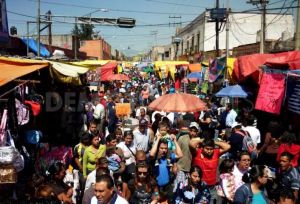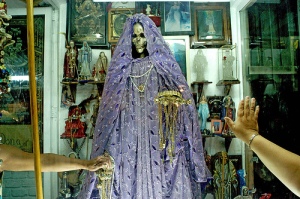The first time I heard about Tepito was on a late-night taxi ride to Mexico City’s northern bus station on the way to one of the many trips that I took while I lived in that sprawling city. One of the first things tourists are told when they visit Mexico City (or DF, for Distrito Federal) is to avoid taking taxis from the street, as there have always been kidnappings, robberies, and worse linked to these often unregistered taxis. However, living in DF, being perfectly fluent in Spanish, and being a generally foolhardy and robust twenty-three-year-old, I was not about to take heed of these warnings, which I deemed more appropriate for elderly American tourists. After all, street taxis were cheaper than sitio taxis (which you contract from designated taxi stands), and I was on a budget, having just finished college. So I would always trade a bit of safety for economy and convenience and hail taxis wherever and whenever I needed them. I would, however, take the precautions of immediately locking both back doors upon entering a taxi, and pulling up Google Maps on my phone to track the taxi’s course, to make sure that it wasn’t taking any detours to charge me more, or, you know, kidnap me. These habits were initially a bit difficult to break when I moved to New York City, to the amusement of any friend I would share a taxi with.
My willingness to take street taxis exhibited my tendency for risk-taking and my thirst for adventure, so often prevalent in young twenty-somethings living in foreign countries. So when my taxi driver indicated Tepito as the neighborhood he had grown up in, to the east of the freeway we were driving up that night to get to the bus station, my ears perked up as he told me stories about his miscreant youth, rife with anecdotes of gangs, misdemeanor crimes, and other such gritty urban tales. He mentioned his scars from bullets and knife wounds, and I learned that although he was only twenty years older than me, he was already a grandfather. When I returned to DF, I did a bit of research on Tepito and vowed to check it out for myself.
So one sunny Saturday afternoon (I wasn’t about to go at night), I pulled on some army camouflage pants, my dirtiest boots, an old gym shirt, and some aviators, with just a couple metro tickets and a bit of cash in my pocket, and hopped onto the metro to Tepito. Luckily, I have brown skin, so many times in Mexico I think people just assumed I was Mexican until the moment I opened my mouth and my accent was revealed. I emerged from the metro station and walked with confidence through the sprawling market, perusing the offerings, looking for the few mundane items I needed (a yoga mat, bootleg sunglasses, a water boiler). I had to admit that Tepito was a lot less intimidating than I thought – it was full of people, no one really seemed to give me a second thought, I saw a bit of police presence, and the sun was shining.
(Just another day in Tepito)
 (Who wants a completely legitimate movie for ten pesos?)
(Who wants a completely legitimate movie for ten pesos?)
They say that you can buy anything in Tepito, except dignity. I had heard stories of friends of friends going into underground tunnels where the merchants of Tepito sold all kinds of arms, illegal animals, and other illicit offerings of all sorts. However, I wasn’t about to start asking around for anything I wasn’t serious about buying, as I didn’t really feel like being kidnapped/murdered that day. I did see a ton of pirated media, but that’s a fairly common sight in any big market in Mexico. In Tepito there were even stands that sold the labels with which to cover pirated DVDs, a wholesaler to smaller merchants of pirated goods, if you will. I also saw a few stands selling all kinds of army and defense equipment and paraphernalia: knives of all kinds, protective gear, mace, Tasers, military clothing, and even Nazi flags, which I found quite shocking and offensive (I told the merchant: “No deberías vender esto” – “You shouldn’t sell that”, but he just shrugged), but I suppose they don’t really carry the same cultural significance in Mexico that they do in the U.S. and Europe.
Shopping can be so exhausting, whether you’re in Barney’s or in Tepito! I eventually stopped for a small lunch at a dodgy food stand (they were all dodgy) and enjoyed some tacos, which were prepared in quite unsanitary conditions, but luckily I have a strong stomach which I would train almost daily by eating food from street stands. I recommended to the cooks that they at least invest in a antibacterial gel dispenser so that customers could sanitize their hands before eating, but I don’t think they had ever heard of antibacterial gel before judging by their blank stares.
Eventually, I found everything that I needed and had spent the last of the few pesos that I had set out with, so I started heading south to the mariachi-filled and touristic Plaza Garibaldi to reach safer surroundings. On my way, I was drawn by the brightly colored quinceañera gowns in a shop window, so I ventured into a small market filled with the vivid, visually-assaulting dresses, hoping to get a good picture. While wandering through the technicolor wonderland, a coy, elderly voice suddenly called out to me, “Te van a robaaar” – “They’re going to rooob you”.
I whipped around to see a small elderly woman sitting in a chair, rocking back and forth and smiling at me peacefully. Shocked she had seen through my attempt to blend in with the locals, I responded doubtfully, “Pero me veo turista?!” – “Do I really look like a tourist?!”
To which she answered nonchalantly, “Completamente”, as a few boys snickered behind her and looked me up and down. Shocked and offended, I hustled out of there and hopped on the metro, thanking my lucky stars nobody had decided to rob me even though despite my best efforts, I had apparently screamed “tourist” the whole time I was wandering through the depths of Tepito.
WHEN: Year-round, but during the day, for God’s sake.
WHERE: The Tepito neighborhood – enter at your own risk. Metro Tepito, or Metro Lagunilla to emerge in the less notorious Lagunilla Market, adjacent to Tepito, which provides a good starting point to eventually walk into Tepito.
HOT TIP: Leave all your valuables behind, don’t shower or shave for a couple days prior to your visit, don’t wear anything expensive/flashy/clean, and avoid the area in general if you’re any color other than brown or female.
HOT TIP: Many consider la Santa Muerte to be the true patron saint of Tepito, a fitting saint given the amount of crimes that occur in the gang-ridden neighborhood. There is even a shrine dedicated to her, located at 2 Alfarería Street, where devotees leave offerings of fruit, cigarettes, candles, notes, and prayers. Check it out and leave her an offering of your own before you explore to Tepito and you might even come out alive! Buena suerte!






I enjoyed reading your entry about Tepito. I’ve been there plenty of times and I certainly stand out as a foreigner but I’ve never had any problem. Here’s the entry for my visit as part of my metro project http://mexicocitymetro.wordpress.com/2012/04/04/station-estacion-94-tepito/
CHEERS